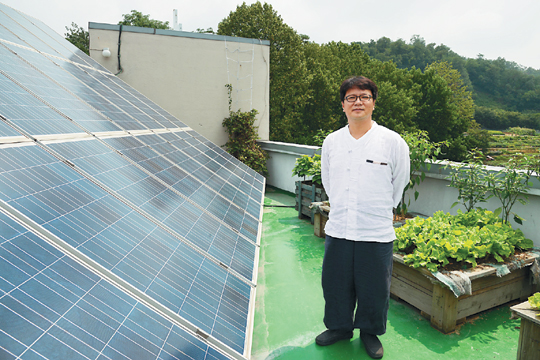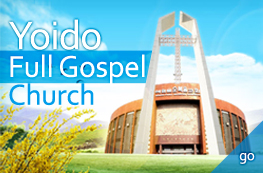The Story of “Green” Jipyeong Church in Bucheon
As there was no signboard on the 5-story building, a rooftop cross was the only clue to its identity as a church. But it was not hard to find Jipyeong Church in Bucheon, Gyonggi-do, because it also has large, black photovoltaic panels standing beside the cross. Jipyeong Church has the distinction of being the first church in Korea to start using solar energy.
“This is a photovoltaic generator. It wasn’t as big as I’d expected. When there’s a lot of sun, it makes about 4 kilowatts of energy per hour. Though there are some bad-weather days, in one year it produces about 3,600 kw. It’s amazing that we can make electricity with the sunshine - God’s blessing to everyone. In the sunlight, I feel the Holy Spirit is with us in community.”
Lee Taek-kyu, the pastor of Jipyeong Church, spoke with a big smile on August 29, as he lovingly touched the solar panels here and there. Hanging in one corner of the ceiling in the first-floor restaurant where I was interviewing him, a small-scale model of the photovoltaic generator was on display. A single glance clarified that the church’s title “Green Church,” as shown on the sign beside the basement worship hall, was a good fit.
Jipyeong Church’s photovoltaic energy system was installed eight years ago. At the beginning of 2006, Rev. Lee received a request from close acquaintance Park Seung-ok, director of the board of Seoul Citizens’ Solar Power Co-op. “Rev. Lee, we want to set up a solar energy system. Could you possibly let us use your roof?” Rev. Lee readily agreed to this proposal.
Good luck followed. The members of Seoul Citizens’ Solar Power Co-op bore the burden of the total installation costs. The only condition was that Jipyeong Church let its rooftop be used. It was agreed that for 15 years the Citizens’ Solar Power Co-op would operate the system, after which it would be operated by the church. Since the government’s interest in new, renewable energy was high at the time, the price paid by Korea Electric Power Corporation for electricity produced by solar generation was a generous 716.4 won per kilowatt. Thanks to this, the Citizens’ Solar Power Co-op had already recovered more than half of the installation cost of 24 million won. That is, while protecting the environment, they gained economic benefit.
After earning the title of Korea’s first solar energy-generating church, Jipyeong Church began transforming into a “green church.” It started with small projects such as a “low carbon-dioxide diet.” The fourth Sunday of each month was named “Carless Churchgoing Day,” in a movement to reduce carbon dioxide at least a little. Following that, the church made a “carbon dioxide housekeeping book.” This helped the members of each family make frugality a part of their daily life, as they drew a graph showing the amount of electricity they had used each month.
“We stuck the graphs on the wall of the first-floor fellowship room so the church members could see each other’s results. Personally drawing the graph of your electricity use awakens you to the reality. That act alone is enough to bring energy-saving effects.”
They also made a garden on the church roof. Alongside the solar panels, Rev. Lee and the church members placed 60 some styrofoam boxes in which they are growing leaf lettuce, cucumbers, eggplant, sesame leaves and other vegetables. As they share their vegetables with local residents, they are also cultivating acquaintance with their neighbors. In each month that has five Sundays, the fifth one is the occasion for a “Life Candlelight Worship,” with no use of electricity. No matter how hot it is, the air conditioner is not turned on; however cold it may be, no heater is used.
Even as he introduced Jipyeong Church, Rev. Lee was shy about standing out. He said that there were many ministers who had worked long and with more dedication than he; he hadn’t even known the difference between sunlight and solar heat; how could he suddenly be a minister representing the environmental movement? But when he talked about the importance of the mission to protect the environment, his voice became strong. He expressed his dissatisfaction with persons who view this mission negatively, judging it from an ideological or political perspective.
“In the church, is it wrong to say, ‘Let’s protect the environment’? It’s simply saying, ‘Let’s keep God’s created world beautiful.’ But there are some persons who, on the contrary, oppose environmental protection, looking at it from a political viewpoint. In today’s society, God’s created world has been turned into a place for humans only. The churches need to take action for environmental protection, to recover God’s world.”
Reporter Jin Samyeol (samuel@kmib.co.kr) from Bucheon, with Marion Kim (marionkkim@icloud.com)
Photo by intern reporter Heo Ran from Bucheon
Click here for the original article in Korean
Related Article
Feeling Holy Spirit Presence in the Sunshine: 8th Year of Photovoltaic Energy System
2014-09-04 16:57



